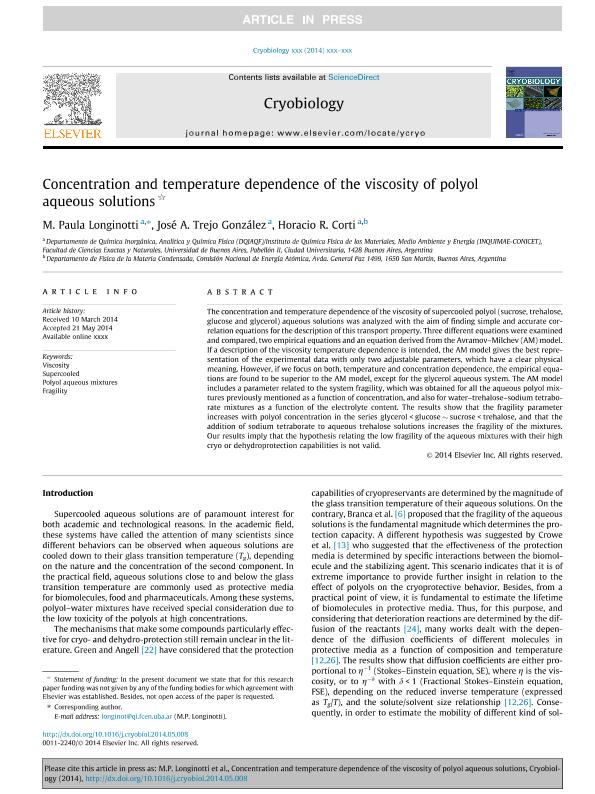Mostrar el registro sencillo del ítem
dc.contributor.author
Longinotti, María Paula

dc.contributor.author
Trejo González, José Adolfo

dc.contributor.author
Corti, Horacio Roberto

dc.date.available
2018-01-17T15:17:21Z
dc.date.issued
2014-05
dc.identifier.citation
Corti, Horacio Roberto; Trejo González, José Adolfo; Longinotti, María Paula; Concentration and temperature dependence of the viscosity of polyol aqueous solutions; Elsevier; Cryobiology; 69; 1; 5-2014; 84-90
dc.identifier.issn
0011-2240
dc.identifier.uri
http://hdl.handle.net/11336/33591
dc.description.abstract
The concentration and temperature dependence of the viscosity of supercooled polyol (sucrose, trehalose, glucose and glycerol) aqueous solutions was analyzed with the aim of finding simple and accurate correlation equations for the description of this transport property. Three different equations were examined and compared, two empirical equations and an equation derived from the Avramov–Milchev (AM) model. If a description of the viscosity temperature dependence is intended, the AM model gives the best representation of the experimental data with only two adjustable parameters, which have a clear physical meaning. However, if we focus on both, temperature and concentration dependence, the empirical equations are found to be superior to the AM model, except for the glycerol aqueous system. The AM model includes a parameter related to the system fragility, which was obtained for all the aqueous polyol mixtures previously mentioned as a function of concentration, and also for water–trehalose–sodium tetraborate mixtures as a function of the electrolyte content. The results show that the fragility parameter increases with polyol concentration in the series glycerol < glucose ∼ sucrose < trehalose, and that the addition of sodium tetraborate to aqueous trehalose solutions increases the fragility of the mixtures. Our results imply that the hypothesis relating the low fragility of the aqueous mixtures with their high cryo or dehydroprotection capabilities is not valid.
dc.format
application/pdf
dc.language.iso
eng
dc.publisher
Elsevier

dc.rights
info:eu-repo/semantics/openAccess
dc.rights.uri
https://creativecommons.org/licenses/by-nc-sa/2.5/ar/
dc.subject
Viscosity
dc.subject
Supercooled
dc.subject
Polyol Aqueous Mixtures
dc.subject
Fragility
dc.subject.classification
Otras Ciencias Químicas

dc.subject.classification
Ciencias Químicas

dc.subject.classification
CIENCIAS NATURALES Y EXACTAS

dc.title
Concentration and temperature dependence of the viscosity of polyol aqueous solutions
dc.type
info:eu-repo/semantics/article
dc.type
info:ar-repo/semantics/artículo
dc.type
info:eu-repo/semantics/publishedVersion
dc.date.updated
2018-01-16T18:01:34Z
dc.journal.volume
69
dc.journal.number
1
dc.journal.pagination
84-90
dc.journal.pais
Países Bajos

dc.journal.ciudad
Ámsterdam
dc.description.fil
Fil: Longinotti, María Paula. Universidad de Buenos Aires. Facultad de Ciencias Exactas y Naturales. Departamento de Química Inorgánica, Analítica y Química Física; Argentina. Consejo Nacional de Investigaciones Científicas y Técnicas. Oficina de Coordinación Administrativa Ciudad Universitaria. Instituto de Química, Física de los Materiales, Medioambiente y Energía. Universidad de Buenos Aires. Facultad de Ciencias Exactas y Naturales. Instituto de Química, Física de los Materiales, Medioambiente y Energía; Argentina
dc.description.fil
Fil: Trejo González, José Adolfo. Universidad de Buenos Aires. Facultad de Ciencias Exactas y Naturales. Departamento de Química Inorgánica, Analítica y Química Física; Argentina. Consejo Nacional de Investigaciones Científicas y Técnicas. Oficina de Coordinación Administrativa Ciudad Universitaria. Instituto de Química, Física de los Materiales, Medioambiente y Energía. Universidad de Buenos Aires. Facultad de Ciencias Exactas y Naturales. Instituto de Química, Física de los Materiales, Medioambiente y Energía; Argentina
dc.description.fil
Fil: Corti, Horacio Roberto. Universidad de Buenos Aires. Facultad de Ciencias Exactas y Naturales. Departamento de Química Inorgánica, Analítica y Química Física; Argentina. Consejo Nacional de Investigaciones Científicas y Técnicas. Oficina de Coordinación Administrativa Ciudad Universitaria. Instituto de Química, Física de los Materiales, Medioambiente y Energía. Universidad de Buenos Aires. Facultad de Ciencias Exactas y Naturales. Instituto de Química, Física de los Materiales, Medioambiente y Energía; Argentina. Comisión Nacional de Energía Atómica; Argentina
dc.journal.title
Cryobiology

dc.relation.alternativeid
info:eu-repo/semantics/altIdentifier/url/https://www.sciencedirect.com/science/article/pii/S0011224014001199
dc.relation.alternativeid
info:eu-repo/semantics/altIdentifier/doi/http://dx.doi.org/10.1016/j.cryobiol.2014.05.008
Archivos asociados
